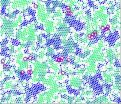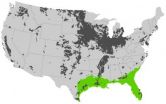(Press-News.org) The phrase, 'Eat your vitamins,' applies to marine animals just like humans. Many vitamins, including B-12, are elusive in the ocean environment.
University of Washington researchers used new tools to measure and track B-12 vitamins in the ocean. Once believed to be manufactured only by marine bacteria, the new results show that a whole different class of organism, archaea, can supply this essential vitamin. The results were presented Feb. 24 at the Ocean Sciences meeting in Honolulu.
"The dominant paradigm has been bacteria are out there, making B-12, but it turns out that one of the most common marine bacteria doesn't make it," said Anitra Ingalls, a UW associate professor of oceanography.
All marine animals, some marine bacteria and some tiny marine algae, or phytoplankton, need B-12, but only some microbes can produce the large, complex molecule. So like human vegetarians on land, marine organisms may be scouring for food that can help stave off vitamin deficiency.
"If only certain bacteria can make B vitamins, that can make B-12 a controlling factor in the environment. Is it present or not?" said Katherine Heal, a UW oceanography graduate student. "Studying the marine microbiome can help us understand what microbial communities could be supported where, and how that affects things like the ocean's capacity to absorb atmospheric CO2."
The UW team is the first to show that marine archaea, a single-celled organism that evolved totally separate from bacteria and all other living things, are making B-12. Relatives of these tiny critters are known for unusual behavior like living inside hot springs and underwater volcanoes.
The Seattle team managed to grow a common type of open-ocean archaea in the lab, no mean feat, and show that it not only makes enough B-12 to support its own growth but can supply some to the environment.
"It's hard to quantify their contribution," Ingalls said. "This is a first glimpse at their potential to contribute to this pool of vitamins."
The analysis was done at a new UW marine chemistry center that does detailed analysis of proteins and other carbon-based chemicals in the ocean. The researchers used high-tech tools, including liquid chromatography and mass spectrometry, to identify the tiny amount of vitamins among all the dissolved matter and salt in the seawater. The UW method is unique in that it is the only one that can distinguish among the four forms of B-12 vitamins.
Field experiments involved sampling seawater in Hood Canal, near Seattle, and in the Pacific Ocean hundreds of miles offshore. The results showed that B-12 was present in small amounts in all water samples. Concentrations were low enough in some places that vitamin deficiency among tiny marine algae, or phytoplankton, is likely.
"Having a very small amount doesn't mean there's a very small supply," Ingalls said. "Low concentrations can indicate something that's highly desirable to marine organisms."
The next step, researchers said, is to connect different microbes' activity with the production of B vitamins, to see which organisms are responsible where, and to look at how ocean vitamins affect the type and amount of phytoplankton growing in the water.
Recent sequencing of the genomes of marine microbes has revealed genetic pathways in bacteria and archaea for creating B vitamins, but just because the gene is there doesn't mean it's being used. Marine microbes often adapt their behavior depending on the environment. In the case of vitamins, some bacteria make more B-12 if a phytoplankton is nearby, supporting their eventual food source.
Making a B-12 vitamin, which has a metal core and complex surrounding structure, involves 30-some steps.
"People think that's why many organisms have lost it from their genomes," Heal said. "It's just too expensive to make it, and it's easier to get it from food."
The UW team hopes to learn which microbes are producing B-12 vitamins where, to better understand how the base of the marine food web works, how it might alter in a changing environment, how oceans might help regulate atmospheric carbon dioxide, and where marine animals could go to get a well-balanced diet.
"The public really has a very strange relationship to microorganisms," Ingalls said. "People know they cause disease, so they want to kill them. But they're also the only reason that we – or whales, fish or coral reefs – are alive."
INFORMATION:
Collaborators are David Stahl, E. Virginia Armbrust, Allan Devol, Wei Qin and Laura Carlson at the UW, James Moffett at the University of Southern California and Willow Coyote, an undergraduate from Evergreen State College who will also present a poster at the meeting. The work was funded by the National Science Foundation.
For more information, contact Ingalls at 206-221-6748 or aingalls@uw.edu and Heal at 206-543-7521 or kheal@uw.edu.
Vitamin water: Measuring essential nutrients in the ocean
2014-02-24
ELSE PRESS RELEASES FROM THIS DATE:
OU researcher and team discover disease-causing bacteria in dental plaque preserved for 1,000 years
2014-02-24
When a University of Oklahoma researcher and an international team of experts analyzed the dental calculus or plaque from teeth preserved for 1,000 years, the results revealed human health and dietary information never seen before. The team discovered disease-causing bacteria in a German Medieval population, which is the same or very similar to inflammatory disease-causing bacteria in humans today—unlikely scientific results given modern hygiene and dental health practices.
Christina Warinner, research associate in the Molecular Anthropologies Laboratories, OU College ...
Gauging what it takes to heal a disaster-ravaged forest
2014-02-24
Recovering from natural disasters usually means rebuilding infrastructure and reassembling human lives. Yet ecologically sensitive areas need to heal, too, and scientists are pioneering new methods to assess nature's recovery and guide human intervention.
The epicenter of China's devastating Wenchuan earthquake in 2008 was in the Wolong Nature Reserve, a globally important valuable biodiversity hotspot and home to the beloved and endangered giant pandas. Not only did the quake devastate villages and roads, but the earth split open and swallowed sections of the forests ...
Penn researchers 'design for failure' with model material
2014-02-24
When deciding what materials to use in building something, determining how those materials respond to stress and strain is often the first task. A material's macroscopic, or bulk, properties in this area — whether it can spring back into shape, for example — is generally the product of what is happening on a microscopic scale. When stress causes a material's constituent molecules to rearrange in a way such that they can't go back to their original positions, it is known as "plastic deformation."
Researchers at the University of Pennsylvania have devised a method to study ...
Parents' attitudes about helping their grown children affect their mental health
2014-02-24
Older parents frequently give help to their middle-aged offspring, and their perceptions about giving this help may affect their mental health, according to a team of researchers.
"We usually view the elderly as needy, but our research shows that parents ages 60 and over are giving help to their children, and this support is often associated with lower rates of depression among the older adults," said Lauren Bangerter, Ph.D. student in human development and family studies, Penn State.
The team -- which included researchers at Penn State, the University of Texas ...
Specialized cognitive therapy improves blood sugar control in depressed diabetes patients
2014-02-24
Although maintaining good blood sugar control is crucial for avoiding complications of diabetes, it has been estimated that only about half of patients are successful in meeting target blood glucose levels. The prevalence of depression among diabetes patients – up to twice as high as in the general population – can interfere with patients' ability to manage their diabetes. Now a group of Massachusetts General Hospital (MGH) investigators report that a program of cognitive behavioral therapy that addresses both mood and diabetes self-care led to improved blood sugar control ...
Almost 200 new species of parasitoid wasps named after local parataxonomists in Costa Rica
2014-02-24
An inventory of wild-caught caterpillars, its food plants and parasitoids, has been going on for more than 34 years in Area de Conservación Guanacaste (ACG), a protected area of approximately 1200 km2 in northwestern Costa Rica. As a result, more than 10,000 species of moths and butterflies are estimated to live in ACG. Their caterpillars are in turn attacked by many parasitoid wasps, also numbering thousands of species. However, most of those wasps have never been described and remain unknown.
For the past few years researchers from Canada, Costa Rica and the United ...
New technology detect cellular memory
2014-02-24
Cells in our body are constantly dividing to maintain our body functions. At each division, our DNA code and a whole machinery of supporting components has to be faithfully duplicated to maintain the cell's memory of its own identity. Researchers at BRIC, University of Copenhagen, have developed a new technology that has revealed the dynamic events of this duplication process and the secrets of cellular memory. The results are published in Nature Cell Biology.
In 2009, two women at BRIC, University of Copenhagen joined forces to develop a new technology that could elucidate ...
Researchers make the invisible visible
2014-02-24
The 2003 development of the so-called hyperpolarization technique by a Danish research was a groundbreaking moment that made it possible to see all the body's cells with the help of a new contrast agent for MRI scans. Researchers from Aarhus have now taken another big step towards understanding the body's cells and with it also the development of diseases:
"With the hyperpolarization method, sensitivity to specific contrast agents is up to 10,000 times higher than with a traditional MRI scanning. What we have now documented is that with the hyperpolarization MRI scanning ...
Team converts sugarcane to a cold-tolerant, oil-producing crop
2014-02-24
CHAMPAIGN, Ill. — A multi-institutional team reports that it can increase sugarcane's geographic range, boost its photosynthetic rate by 30 percent and turn it into an oil-producing crop for biodiesel production.
These are only the first steps in a bigger initiative that will turn sugarcane and sorghum – two of the most productive crop plants known – into even more productive, oil-generating plants.
The team will present its latest findings Tuesday (Feb. 25) at the U.S. Department of Energy's ARPA-E Energy Innovation Summit in Washington, D.C.
"Biodiesel is attractive ...
Pointing is infants' first communicative gesture
2014-02-24
VIDEO:
Catalan researchers have studied the acquisition and development of language in babies on the basis of the temporary coordination of gestures and speech. The results are the first in showing...
Click here for more information.
Catalan researchers have studied the acquisition and development of language in babies on the basis of the temporary coordination of gestures and speech. The results are the first in showing how and when they acquire the pattern of coordination ...






